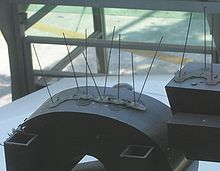- Feral Pigeon
-
Feral Rock Pigeon 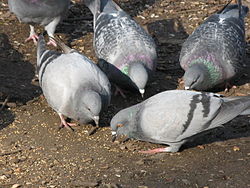
Feral Rock Pigeons feeding in a park Conservation status Scientific classification Kingdom: Animalia Phylum: Chordata Class: Aves Order: Columbiformes Family: Columbidae Genus: Columba Species: C. livia Binomial name Columba livia
Gmelin, 1789
Distribution Feral pigeons (Columba livia), also called city doves, flying rats, city pigeons or street pigeons, are derived from domestic pigeons that have returned to the wild.[1] The domestic pigeon was originally bred from the wild Rock Pigeon, which naturally inhabits sea-cliffs and mountains.[2] All three types readily interbreed. Feral pigeons find the ledges of buildings to be a substitute for sea cliffs, and have become adapted to urban life and are abundant in towns and cities throughout much of the world.[3]
Contents
Breeding
Courtship
 Courting pigeons in Kolkata
Courting pigeons in Kolkata
As a result of the continuous food supply, pigeon courtship rituals can be observed in urban parks at any time of the year. A male on the ground initially puffs up his feathers at the nape of the neck to appear larger and thereby impress or attract attention. He then singles out a female in the vicinity and approaches her at a rapid walking pace while emitting repetitive quiet notes, often bowing and turning as he comes closer.
Initially, the female invariably walks or flies a short distance away, and the male follows her. Persistence by the male will usually eventually cause the female to tolerate his proximity, at which point he will continue the bowing motion and very often make full- or half-pirouettes in front of the female.
The male then mounts the female. The mating is very brief with the male flapping his wings to maintain balance on top of the female. Sometimes the male and female beaks lock together.
Nesting
Nests are rudimentary, similar to for wild doves and pigeons.
Abandoned buildings are favourite nesting areas. Mass nesting is common, often dozens of birds will share a building. Loose tiles and broken windows give pigeons access; they are good at spotting new access points, for example following property damage caused by strong winds.
Nests and droppings will quickly make a mess of any nesting area. Pigeons are particularly fond of roof spaces. These often contain water tanks, into which the pigeons can defecate or chicks can fall into the tanks and drown. Any water tank or cistern on a roof must therefore be secured and sealed off.
The popularity of a nesting area does not seem to be affected by pigeons dieing there. Corpses are often seen among unconcerned live birds.
On undamaged property, the gutters, window air conditioners and empty air conditioner containers, chimney pots and external ledges are used as nesting sites. Many building owners try to limit roosting by using bird control spikes and netting to cover ledges and potential nesting places on buildings. This probably has little effect on the size of the pigeon population, but it can reduce the accumulation of droppings on and around a particular building.
Only the larger and more wary Common Wood Pigeon, which often shares the same territory and food supply, will build nests in trees, usually close to roads.
Cooing
In Wendell Levi's The Pigeon, he describes the crowing/cooing of pigeons as mostly being associated with strutting and fighting in male birds.[2] Hens will also coo, but this is noticeably less guttural than the cooing of the cock. Cooing is also more frequent between couples during mating and nesting.
Both parents participate in the incubation of the eggs.
Food
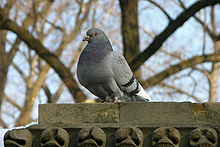 A pigeon perched in Central Park
A pigeon perched in Central Park
Pigeons breed when the food supply is good, which in cities can be any time of the year. Laying of eggs can take place up to six times per year.
In the wild the pigeons are often found in pairs during the breeding season, but usually the pigeons are gregarious.[4]
Video showing a pigeon eating seeds
Feral pigeons can be seen eating grass seeds and berries in parks and gardens in the spring, but there are plentiful sources throughout the year from scavenging (e.g., dropped fast-food cartons) and they will also take insects and spiders. Further food is also usually available from the disposing of stale bread in parks by restaurants and supermarkets, from tourists buying and distributing birdseed, etc. Pigeons tend to congregate in large, often thick flocks when going for discarded food, and many have been observed flying skilfully around trees, buildings, telephone poles and cables, and even moving traffic just to reach it.
See also: Reproduction of Rock PigeonsCities famous for pigeons
Many city squares are famous for their large pigeon populations, for example, the Piazza San Marco in Venice, and Trafalgar Square in London. For many years, the pigeons in Trafalgar Square were considered a tourist attraction, with street vendors selling packets of seeds for visitors to feed the pigeons. The feeding of the Trafalgar Square pigeons was controversially banned[5] in 2003 by London mayor Ken Livingstone. However, activist groups such as Save the Trafalgar Square Pigeons[6] flouted the ban, feeding the pigeons from an area south of Nelson's Column in which the ban does not apply. The organisation has since come to an agreement to feed the pigeons only once a day, at 7:30 a.m.[7]
Population control
See also: Animal population controlFeral pigeons often only have small populations within cities. For example, the breeding population of feral pigeons in Sheffield, England, has been estimated at only 12,130 individuals.[8] Despite this, feral pigeons usually reach their highest densities in the central portions of cities, so they are frequently encountered by people, which leads to conflict.
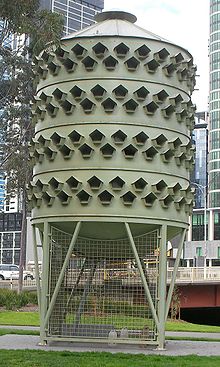 A large pigeon trap/coop/loft at Batman Park, Melbourne. Designed specifically to encourage nesting and allow removal of fertilised eggs to prevent population growth, it is a landmark in its own right.
A large pigeon trap/coop/loft at Batman Park, Melbourne. Designed specifically to encourage nesting and allow removal of fertilised eggs to prevent population growth, it is a landmark in its own right.
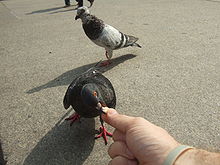 One of the difficulties of controlling pigeon populations is the common practice of feeding them, as here in New York.
One of the difficulties of controlling pigeon populations is the common practice of feeding them, as here in New York.
Feral pigeons are often considered a pest or even as vermin, owing to concerns that they spread disease[9] and are much maligned in the media for transmitting bird flu, but it has been shown pigeons do not carry the deadly H5N1 strain.[10][11] Also concerns of them damaging property, causing pollution with their excrement, and driving out other bird species. Some also consider pigeons an invasive species.[12]
While pest exterminators use poison, hawks and nets have also been employed at ground level to control urban pigeon populations, though this generally achieves only a limited, temporary effect.
Long-term reduction of feral pigeon populations can be achieved by restricting food supply, which in turn involves legislation and litter (garbage) control. Some cities have deliberately established favorable nesting places for pigeons – nesting places that can easily be reached by city workers who regularly remove eggs, thereby limiting their reproductive success.[13]
Peregrine Falcons
Peregrine Falcons which are also originally cliff dwellers have also adapted to the big cities, living on the window ledges of skyscrapers and often feeding exclusively on Rock Pigeons.[14] Some cities actively encourage this through falcon breeding programs. Projects include Unibase Falcon project and the Victorian Peregrine Project.
Larger birds of prey occasionally take advantage of this population as well. In New York City, the abundance of pigeons (and other vermin) has created such a conducive environment for predators that the Red-Tailed Hawk has begun to return in very small numbers, the most famous of which is Pale Male.
Poison
Due to their non-selective nature, most avian poisons have been banned. In the United States market only 4-aminopyridine (Avitrol) and DRC-1339 remained registered by EPA. DRC-1339 is limited to USDA use only while 4-AP is a restricted use pesticide, for use only by licensed applicators.
The use of poisons has been proven to be fairly ineffective, however, as pigeons can breed very quickly — up to six times a year — and their numbers are determined by how much food is available; that is, they breed more often when more food is provided to them.
When pigeons are poisoned, surviving birds do not leave the area. On the contrary, they are left with more food per bird than before. This attracts pigeons from outside areas as well as encouraging more breeding, and populations are re-established quickly.[13] An additional problem with poisoning is that it also kills pigeon predators. Due to this, in cities with Peregrine Falcon programs it is typically illegal to poison pigeons.[14]
Reducing food supply
A more effective tactic to reduce the number of feral pigeons is deprivation.[15][16] Cities around the world have discovered that not feeding their local birds results in a steady population decrease in only a few years. Pigeons, however, will still pick at garbage bags containing discarded food or at leftovers carelessly dropped on the ground. Feeding of pigeons is banned in parts of Venice, Italy.[17]
Avian contraceptives
See also: Wildlife contraceptiveIn 1998, in response to conservation groups and the public interest, the National Wildlife Research Center (NWRC), a USDA/APHIS laboratory in Fort Collins, Colorado, started work on nicarbazin, a promising compound for avian contraception. Originally developed for use in resident Canada geese, nicarbazin was introduced for use as a contraceptive for feral pigeons in 2007.
The active ingredient, nicarbazin, interferes with the viability of eggs by binding the ZP-3 sperm receptor site in the egg.[18] This unique contraceptive action is non-hormonal and fully reversible.[19]
Registered by the EPA as a pesticide (EPA Reg. No. 80224-1), "OvoControl P", brand of nicarbazin, is increasingly used in urban areas and industrial sites to control pigeon populations. Safe and humane, the new technology is environmentally benign[20] and does not represent a secondary toxicity hazard to raptors or scavengers.[21]
Avian contraception has the support of a range of animal welfare groups including the Humane Society of the United States(HSUS), the American Society for the Prevention of Cruelty to Animals (ASPCA) and People for the Ethical Treatment of Animals (PETA).
USDA continues to develop wildlife contraceptives, including the recently registered Gonadotropin-releasing hormone (GnRH) for deer and Diazacon for birds and small mammals. Further development and registrations of Porcine Zona Pellucida or PZP, another immunocontraceptive targeted for feral horses, is supported by HSUS. The new field of wildlife contraceptives is developing rapidly and promises a bright future for the safe, effective and humane management of animal populations.
Dummy egg nesting
Dummy egg nesting programs have been tested in some cities with mixed results. Nest or coop structures are erected and the eggs are removed and replaced with dummy eggs. The eggs are then disposed of to prevent the pigeons breeding. Such structures are being used in New York City[citation needed] and also the Melbourne city centre by the Melbourne City Council at Batman Park[22][22][23] The loft used in Melbourne is on stilts, with a cage door allowing access from beneath for accessing structure at night when the pigeons are asleep.
See also
- Birdfeeding
- Doves as Symbols
References
- ^ "Science & Nature: Animals: Feral Pigeon" (Web article). BBC.CO.UK. http://www.bbc.co.uk/nature/wildfacts/factfiles/3030.shtml. Retrieved 2008-01-05.
- ^ a b Levi, Wendell (1977). The Pigeon. Sumter, S.C.: Levi Publishing Co, Inc. ISBN 0853900132.
- ^ "WHY STUDY PIGEONS? To understand why there are so many colors of feral pigeons." (Web Article). Cornell Lab of Ornithology. http://www.birds.cornell.edu/programs/urbanbirds/about/ubs_PIWWhyStudyEN.html. Retrieved 2008-01-06.
- ^ Gibbs, David; Eustace Barnes, John Cox. Pigeons and Doves: A Guide to the Pigeons and Doves of the World. United Kingdom: Pica Press. pp. 624. ISBN 1873403607. http://books.google.com/?id=aeZXAAAACAAJ&dq=Pigeons+and+Doves:+A+Guide+to+the+Pigeons+and+Doves+of+the+World.
- ^ "Feeding Trafalgar's pigeons illegal". BBC News. 2003-11-17. http://news.bbc.co.uk/1/hi/england/london/3275233.stm.
- ^ Save the Trafalgar Square Pigeons
- ^ Save the Trafalgar Square Pigeons - Background
- ^ Fuller RA, Tratalos J, Gaston KJ (2009). "How many birds are there in a city of half a million people?". Diversity and Distributions 15 (2): 328–337. doi:10.1111/j.1472-4642.2008.00537.x.doi:10.1111/j.1472-4642.2008.00537.x
- ^ "Facts about pigeon-related diseases" (Web article). The New York City Department of Health and Mental Hygiene. http://www.nyc.gov/html/doh/html/epi/epi-pigeon.shtml. Retrieved 2008-01-04.
- ^ Turner, Brad. "Avian flu virus H5N1 and pigeons: the facts." (Web article). Purebred Pigeon Magazine. http://www.purebredpigeon.com/avianflu.htm. Retrieved 2008-01-04.
- ^ Panigrahy B, Senne DA, Pedersen JC, Shafer AL, Pearson JE (1996). "Susceptibility of pigeons to avian influenza". Avian Dis. (American Association of Avian Pathologists, Inc.) 40 (3): 600–4. doi:10.2307/1592270. JSTOR 1592270. PMID 8883790.
- ^ Paulik, Laurie. "Pigeons" (Web article). AgNIC Wildlife Damage Management. http://lib.colostate.edu/research/agnic/invspecies/pigeons.html. Retrieved 2008-01-04.
- ^ a b Blechman, Andrew (2007). Pigeons-The fascinating saga of the world's most revered and reviled bird.. St Lucia, Queensland: University of Queensland Press. ISBN 9780702236419. http://andrewblechman.com/pigeons/learn_more.html.
- ^ a b "Fastest bird on earth enjoys family time high above city street". The Age (Melbourne). 2007-10-19. http://www.theage.com.au/news/national/fastest-bird-on-earth-enjoys-family-time-high-above-city-street/2007/10/18/1192300954573.html.
- ^ Feral Pigeons in Bexley
- ^ About Pigeons
- ^ http://www.iht.com/articles/2008/05/08/europe/pigeon.php
- ^ Reinoso, V., A. MacDonald and G.F. Barbato. Nicarbazin reduces egg production and fertility in White Pekin Ducks. Accepted for publication in Poultry Science.
- ^ Avery, M., K. Keacher, and E. Tillman. Nicarbazin bait reduces reproduction by pigeons (Columba livia). 2008. Wildlife Research 35(1) 80-85
- ^ EPA Fact Sheet: Nicarbazin http://www.epa.gov/opprd001/factsheets/nicarbazin.pdf
- ^ http://ovocontrol.com/wp-content/uploads/2010/03/Secondary-Toxicity-of-Nicarbazin-in-Birds.pdf
- ^ a b http://www.abc.net.au/rn/rearvision/stories/2008/2109322.htm
- ^ http://www.melbourne.vic.gov.au/opm/bc/CTEE/meetings/CSCaCD_51_20040907.pdf
Books
- Levi, Wendell (1977). The Pigeon. Sumter, S.C.: Levi Publishing Co, Inc. ISBN 0853900132.
Categories:- IUCN Red List least concern species
- Columba
- Cosmopolitan species
- Domesticated birds
- Introduced birds
- Invasive animal species
- Birds of Canada
- Birds of Europe
- Birds of North America
- Urban animals
- Feral animals
Wikimedia Foundation. 2010.




